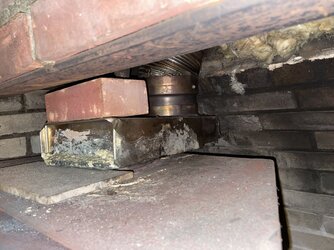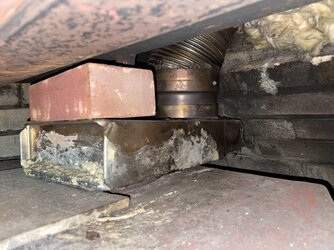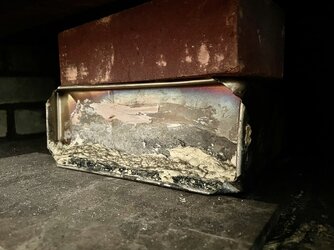Hi, all! First post here. A few years ago, we moved into a home that was previously owned by a big wood burning stove aficionado. We have a forced air furnace, and do not rely on the stove for primary heat. However, we have a ton of seasoned wood, as we live against some forest (I split and stack it properly), and I also love to burn fires in this thing for supplementary heat, and general enjoyment. We also have a new baby, so I would like to have a backup heat source for the house.
The previous owner (not the stove wizard — this more recent owner was clearly a little cheap and negligent) did not give me much info on how to maintain our Lopi Freedom Bay (1998), and I’ll admit that I should have done some of my own homework after the first year of occasional burns. The stove now seeps smoke out of the bottom intake when the door is closed — even when my kindling has been aflame to a decent degree with the bypass open. Once I close the door, the yellow flames die, and the whole thing starts spewing smoke. It filled the whole house not once but TWICE while my in-laws were visiting. They probably think I’m an idiot 😅
What I am looking for is advice on possible points of failure, and what I can do in terms of maintenance to prevent this sort of thing. Some info for you all:
1) I know for certain the door no longer has a good seal. The fire rope is loose in parts, and the door handle cam is corroded and loose, and doesn’t pull against the door well. So I will fix those issues myself no matter what.
2) Is it possible that the lower air control assembly could be warped? My guess is that if the yellow flames die when the door is closed, then sufficient air isn’t coming in, even when it’s pulled out and fully open. Is it also possible that ash is accumulating in that vent chamber under the stove?
3) The airtubes have signs of surface corrosion, but they look structurally sound for now. I don’t think they need replacement.
4) I have not yet disassembled the baffle and cleaned out above it. I should be doing this once a year or so (as I’m not burning every day, all day), correct?
5) Damper bypass is clear, and the slider seems to work well.
6) My next area of concern is the offset box leading into our chimney liner. It seems rather narrow, and I can’t tell if it’s a custom job or not. The edges seem crimped together in a way that says to me that someone needed to create their own part. The clearances above the stove and within the fireplace are pretty tight, and the necessary angles are awkward, so it makes sense that they might need to jerry-rig a non-standard offset box. Pics below. Is this a problem? I intend to have a chimney guy come for a general cleaning & inspection, but I would love your opinions.



Thanks for your guidance — let me know if you have any clarifying questions! I really love this thing, and it would be great to extend its useful life for as long as I can!
— WD in NJ
The previous owner (not the stove wizard — this more recent owner was clearly a little cheap and negligent) did not give me much info on how to maintain our Lopi Freedom Bay (1998), and I’ll admit that I should have done some of my own homework after the first year of occasional burns. The stove now seeps smoke out of the bottom intake when the door is closed — even when my kindling has been aflame to a decent degree with the bypass open. Once I close the door, the yellow flames die, and the whole thing starts spewing smoke. It filled the whole house not once but TWICE while my in-laws were visiting. They probably think I’m an idiot 😅
What I am looking for is advice on possible points of failure, and what I can do in terms of maintenance to prevent this sort of thing. Some info for you all:
1) I know for certain the door no longer has a good seal. The fire rope is loose in parts, and the door handle cam is corroded and loose, and doesn’t pull against the door well. So I will fix those issues myself no matter what.
2) Is it possible that the lower air control assembly could be warped? My guess is that if the yellow flames die when the door is closed, then sufficient air isn’t coming in, even when it’s pulled out and fully open. Is it also possible that ash is accumulating in that vent chamber under the stove?
3) The airtubes have signs of surface corrosion, but they look structurally sound for now. I don’t think they need replacement.
4) I have not yet disassembled the baffle and cleaned out above it. I should be doing this once a year or so (as I’m not burning every day, all day), correct?
5) Damper bypass is clear, and the slider seems to work well.
6) My next area of concern is the offset box leading into our chimney liner. It seems rather narrow, and I can’t tell if it’s a custom job or not. The edges seem crimped together in a way that says to me that someone needed to create their own part. The clearances above the stove and within the fireplace are pretty tight, and the necessary angles are awkward, so it makes sense that they might need to jerry-rig a non-standard offset box. Pics below. Is this a problem? I intend to have a chimney guy come for a general cleaning & inspection, but I would love your opinions.



Thanks for your guidance — let me know if you have any clarifying questions! I really love this thing, and it would be great to extend its useful life for as long as I can!
— WD in NJ

